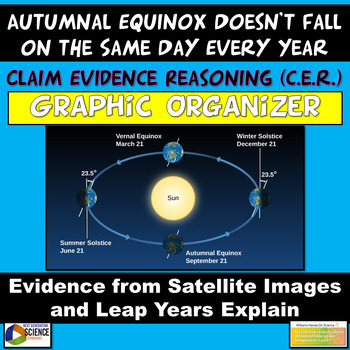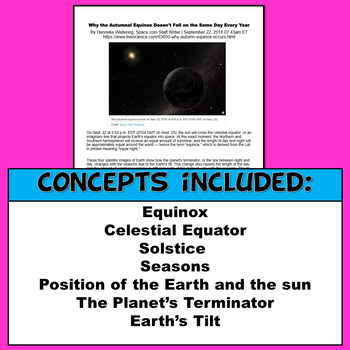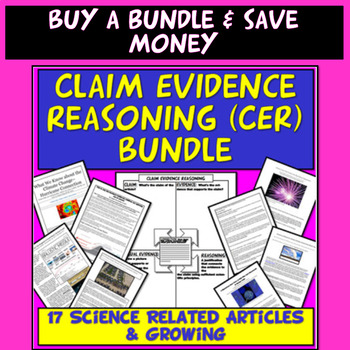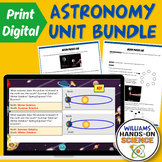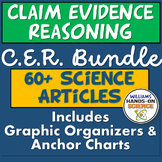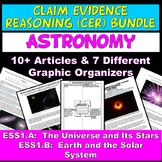Claim Evidence Reasoning (CER): Autumn Equinox Can Fall on Different Days
- Zip
Also included in
- These activities aren’t just you’re ordinary everyday fill in the blank rote worksheets. These are student centered, challenging, hands-on, engaging activities that will wow and motivate even some of the most reluctant learners. I’ve taught, tweaked and improved these products since 2000. I bundledPrice $47.00Original Price $84.00Save $37.00
- This resource is packed with easy to use, easy to grade, no prep, scientific current events, using the NGSS Science and Engineering practice of Engaging in Argument from Evidence. Students learn about a variety of science topics through a C.E.R. (Claim Evidence Reasoning) graphic organizers. This isPrice $47.00Original Price $91.75Save $44.75
- Students learn about various current events and discoveries in Astronomy through a C.E.R. (Claim Evidence Reasoning) graphic organizer. This is great for getting your students to explain phenomena in a meaningful way and it allows you as the instructor to adequately assess their understanding of conPrice $34.00Original Price $66.50Save $32.50
Description
Students learn about why the Autumn Equinox can fall on different days through a C.E.R. (Claim Evidence Reasoning) graphic organizer. This is great for getting your students to explain phenomena in a meaningful way and it allows you as the instructor to adequately assess their understanding of concepts. The students figure out what the "Claim" is in the article, they then use data that supports the claim in the "Evidence" section, draw visual evidence and then explain why the evidence supports the claim in the "Reasoning" section.
You also get a generic template used for any current events that apply to your content. Any time I see an interesting article that applies to what we are learning this is my Go-To template!
You get the following:
-CER Graphic Organizer
-Article to print hard copies and web address for reading off of the computer
-Key
-CER Teacher Tips
The following concepts are included:
Equinox
Celestial Equator
Solstice
Seasons
Position of the Earth and the sun
The Planet’s Terminator
Earth’s Tilt
NGSS Standards:
ESS1.B: Earth and the Solar System
• The solar system consists of the sun and a collection of objects, including planets, their moons, and asteroids that are held in orbit around the sun by its gravitational pull on them.(MS-ESS1-2), (MS-ESS1-3)
• This model of the solar system can explain eclipses of the sun and the moon. Earth’s spin axis is fixed in direction over the short-term but tilted relative to its orbit around the sun. The seasons are a result of that tilt and are caused by the differential intensity of sunlight on different areas of Earth across the year.
(MS-ESS1-1)
SEP1: Asking Questions and Defining Problem
Students at any grade level should be able to ask questions of each other about the texts they read, the features of the phenomena they observe, and the conclusions they draw from their models or scientific investigations.
CCC1: Patterns
Observed patterns of forms and events guide organization and classification, and they prompt questions about relationships and the factors that influence them.
Thank you for taking a look!
Please follow me on TpT for new products and check me out on Instagram for my products in action!
Williamshandsonscience Instagram
⭐ Claim Evidence Reasoning (CER) North Korea Missile Launch
⭐ Claim Evidence Reasoning (CER) The Physics of Car Crashes
⭐ Claim Evidence Reasoning (CER): Autumn Equinox Can Fall on Different Days
⭐ Claim Evidence Reasoning California Mudslides (Current Event and Sub Plan)
⭐ Claim Evidence Reasoning Growing Bundle
⭐ Claim Evidence Reasoning Plate Tectonics Pangaea Article and Graphic Organizer
⭐ Claim Evidence Reasoning: Government Report on Human Caused Climate Change
⭐ Current Event Claim Evidence Reasoning (CER) Graphic Organizer
⭐ Earth, Moon and Sun PowerPoint and Guided Notes
⭐ Hurricane Harvey Claim Evidence Reasoning Graphic Organizer
⭐ Hurricane Harvey Claim Evidence Reasoning Graphic Organizer (NatGeo Article)
⭐ Hurricane Irma CER (Claim Evidence Reasoning) Graphic Organizer
⭐ NGSS Astronomy Resource Bundle: PowerPoint Labs Guided Notes Prezi Board Game
⭐ NGSS Claim Evidence Reasoning (CER) Big Bang Graphic Organizer
⭐ NGSS Claim Evidence Reasoning (CER) High Frequency Sound Waves
⭐ NGSS Claim Evidence Reasoning (CER) Kilauea Volcano Eruption Earthquakes
⭐ NGSS Claim Evidence Reasoning (CER) Oldest Evidence of Life on Land Found
⭐ NGSS Claim Evidence Reasoning The Mysterious Planet Nine Solar System Astronomy
⭐ NGSS Climate Change & Extreme Weather Claim Evidence Reasoning
⭐ NGSS Current Event Claim Evidence Reasoning California Wildfires
⭐ NGSS Current Event Claim Evidence Reasoning Climate Change May Change Ecosystems
⭐ NGSS Earth's Orbit Around The Sun Stop Motion Movie
⭐ NGSS Expanding Universe Claim Evidence Reasoning Graphic Organizer
⭐ NGSS Planets Flier Jigsaw Activity and Gallery Walk
⭐ STEM NGSS Middle School Science Growing MEGA Bundle

